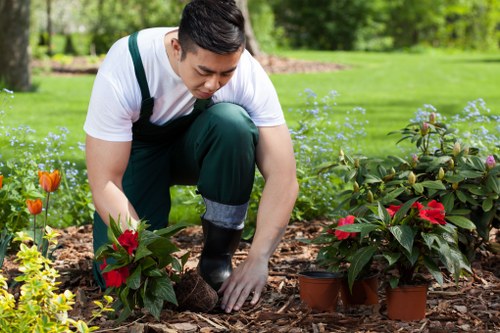Hedge Trimming in Ava Gardening
Introduction to Hedge Trimming

Hedge trimming is an essential aspect of maintaining a beautiful and healthy garden in Ava Gardening. Regular trimming not only enhances the aesthetic appeal of your garden but also promotes the growth and longevity of your hedges. Whether you are a seasoned gardener or a novice, understanding the fundamentals of hedge trimming can make a significant difference in the overall appearance of your outdoor space.
Properly trimmed hedges can serve as natural barriers, providing privacy and defining the boundaries of your property. Additionally, well-maintained hedges contribute to the overall structure of your garden, creating a sense of order and elegance. In Ava Gardening, we emphasize the importance of timely and precise hedge trimming to ensure that your garden remains vibrant and inviting throughout the year.
One of the key benefits of regular hedge trimming is the prevention of overgrowth, which can lead to pests and diseases. By keeping your hedges in check, you reduce the risk of infestations and maintain a healthier environment for your plants. Moreover, hedge trimming encourages new growth, ensuring that your hedges stay lush and full.
Tools and Equipment for Effective Trimming

Having the right tools is crucial for effective hedge trimming. At Ava Gardening, we recommend using quality hedge trimmers, which come in both manual and electric varieties. Manual hedge trimmers are ideal for small to medium-sized hedges and offer greater control for intricate shaping. On the other hand, electric hedge trimmers are suitable for larger hedges, providing power and efficiency to handle more extensive trimming tasks.
In addition to hedge trimmers, other essential tools include pruning shears, loppers, and gloves. Pruning shears are perfect for precise cuts, especially when trimming smaller branches. Loppers are useful for cutting through thicker branches, while gloves protect your hands from thorns and rough surfaces.
Safety should always be a priority when undertaking hedge trimming. Ensure that your tools are in good condition, and always wear appropriate protective gear. Regular maintenance of your equipment, such as sharpening blades and checking for any damage, will prolong their lifespan and ensure optimal performance.
Techniques for Trimming Different Types of Hedges

Different types of hedges require specific trimming techniques to maintain their shape and health. For example, formal hedges, such as boxwood or yew, benefit from regular, precise cuts to maintain their neat and structured appearance. When trimming formal hedges, it is essential to follow a consistent pattern, typically trimming from the bottom up to ensure an even shape.
Informal hedges, like privet or hawthorn, allow for more natural growth and can be trimmed less frequently. When dealing with informal hedges, focus on removing any dead or diseased branches and shaping the hedge to complement the natural landscape of your garden. This approach preserves the inherent texture and variety of the hedge, adding depth and interest to your garden design.
For flowering hedges, timing is critical to ensure that blooming is not disrupted. Trim these hedges immediately after flowering to promote healthy growth and encourage future blooms. Timing your trimming activities appropriately will help maintain the beauty and vibrancy of your flowering hedges.
Seasonal Hedge Trimming Tips

Seasonal changes play a significant role in hedge trimming practices. In spring, focus on removing any winter damage and encouraging new growth. This is an ideal time to perform a thorough trim, setting the stage for a lush and healthy hedge throughout the growing season.
Summer trimming helps manage vigorous growth, preventing hedges from becoming too dense and unmanageable. Light trimmings during this period can help maintain the desired shape and promote better air circulation within the hedge.
Autumn trimming involves preparing hedges for the colder months ahead. Remove any weak or diseased branches and perform a final shaping trim to ensure that your hedges remain healthy during the winter. Avoid heavy trimming in the late fall, as this can stimulate new growth that may be damaged by frost.
Common Mistakes to Avoid

While hedge trimming is straightforward, several common mistakes can negatively impact the health and appearance of your hedges. One such mistake is trimming too late in the season, which can remove essential growth needed for the following year. It is crucial to adhere to the recommended timing for trimming based on the type of hedge you are maintaining.
Another common error is using dull or inappropriate tools. Dull blades can tear the leaves and branches, making the hedge more susceptible to diseases. Always ensure that your trimming tools are sharp and suitable for the specific type of hedge you are working on.
Over-trimming is also a frequent mistake, leading to a thin and weak hedge structure. Instead of removing large sections at once, opt for gradual and regular trimming to maintain a healthy and robust hedge over time.
Benefits of Professional Hedge Trimming Services

Opting for professional hedge trimming services, such as those offered by Ava Gardening, can provide numerous advantages. Professionals bring expertise and experience, ensuring that your hedges are trimmed efficiently and correctly. They are knowledgeable about different hedge types and the specific trimming techniques required to maintain their health and appearance.
Professional services also save you time and effort, allowing you to focus on other aspects of maintaining your garden or enjoying your outdoor space. Additionally, experts can identify and address potential issues, such as pest infestations or disease symptoms, before they become significant problems.
Investing in professional hedge trimming ultimately contributes to the long-term health and beauty of your garden, enhancing your property’s overall value and curb appeal.
Eco-Friendly Trimming Practices

At Ava Gardening, we prioritize eco-friendly hedge trimming practices to promote sustainable gardening. One key practice is the use of organic fertilizers and natural pest control methods, which reduce the reliance on harmful chemicals and protect the environment.
Another important aspect is the responsible disposal of trimmings. Instead of sending cut branches to landfills, consider composting them or using them as mulch to enrich your garden soil. This approach not only reduces waste but also recycles nutrients back into the soil, promoting healthy plant growth.
Furthermore, maintaining healthy hedges through regular trimming can improve biodiversity in your garden. Well-cared-for hedges provide habitats for various species of birds, insects, and other wildlife, contributing to a balanced and thriving ecosystem.
Conclusion and Final Thoughts

Hedge trimming is a vital component of gardening that demands attention, skill, and the right tools. In Ava Gardening, we understand the intricacies involved in maintaining healthy and beautiful hedges, and we are committed to providing top-notch services to our clients.
By following the best practices for hedge trimming, investing in quality tools, and considering professional assistance, you can ensure that your hedges remain a stunning focal point in your garden for years to come. Embrace the art of hedge trimming and transform your garden into a lush and inviting sanctuary.
Ready to enhance your garden with expert hedge trimming? Contact us today or book your service now to experience the Ava Gardening difference.
